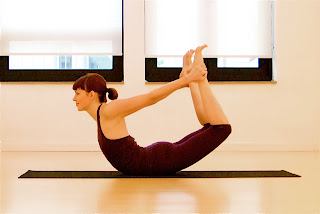The thyroid is akin to a computer’s motherboard producing hormones that regulate the body’s metabolism through back-and-forth chemical conversations with the brain and the pituitary gland. The thyroid can tip into over-production or hyperthyroidism with physical expressions of nervous energy, heat intolerance, menstrual problems, rapid heart rate, and a range of other issues. Low hormone production or hypothyroidism is often misdiagnosed because the symptoms look like aging-fatigue, weight gain, muscle pains, bowel movement changes, mental confusion or forgetfulness, and depression. Both conditions are more common in mature women, ages 30-60.
Hypothyroidism is a condition that can impact anything from your weight to your fertility. What’s unfortunate is that a large chunk of the population has been diagnosed with underactive thyroid(hypothyroidism) and yet there’s few options out there for treatment aside for taking medication. What many people don’t know is that yoga can have quite the impact on the way your thyroid performs. Here’s how yoga can help to improve thyroid imbalance.
Yoga is one of the ancient techniques for dealing with thyroid problems. Regular yoga practice can help to deal with thyroid problems efficiently. Yoga is far more than exercise. It helps to bring mind, body and spirit into perfect balance. It is an excellent alternative for treating people suffering from thyroid diseases. Yoga is recommended by many doctors these days as it stimulates the thyroid glands and helps in balancing metabolism.
Hypothyroidism is a condition that can impact anything from your weight to your fertility. What’s unfortunate is that a large chunk of the population has been diagnosed with underactive thyroid(hypothyroidism) and yet there’s few options out there for treatment aside for taking medication. What many people don’t know is that yoga can have quite the impact on the way your thyroid performs. Here’s how yoga can help to improve thyroid imbalance.
Yoga is one of the ancient techniques for dealing with thyroid problems. Regular yoga practice can help to deal with thyroid problems efficiently. Yoga is far more than exercise. It helps to bring mind, body and spirit into perfect balance. It is an excellent alternative for treating people suffering from thyroid diseases. Yoga is recommended by many doctors these days as it stimulates the thyroid glands and helps in balancing metabolism.
Shoulder stand
1. Place a folded blanket so the upper back and shoulders can rest upon it for support. Lie on your back and ensure that your head and spine are aligned. Legs are straight and feet together.
2. Arms rest along the sides, palms down. Relax your entire Body Mind.
3. Press lower spine gently into the ground, contract the tummy muscles and raise the legs to the sky. Pressing down with arms and palms, smoothly lift the buttocks and roll the spine up and away from the mat.
4. Bend elbows and use your hands to support the backs of your rib cage. Use each and every finger and the palms of each hand to make that connection of warmth and stability. The higher up you place your hands, the straighter your pose will be.
5. Notice how each vertebra feels as each slowly ascends. As the torso raises upward, notice the subtle movement of the cervical spine (back of the neck) Be aware of all sensations your experience.
6. Gently tuck chin into chest. Keep your chest expansive.
7. In the final phase, your legs are vertical, together, and in a straight line with the trunk of your body. Your shoulders, nape of neck and back of the head supports your body. The arms provide support. Your feet are completely relaxed. Your breath is slow, deep and rhythmic.
8. To return, bring straightened legs forward until your feet are above your head. Slowly release your hands and press the arms and palms into the mat for support. Contract the abdomen and gracefully descend, vertebra by vertebra. Lower the buttocks. Press lower spine into the mat as you lower your legs. Keep those knees straight. Retain the breath until you land.
9. Rest. Let your heartbeat and breath quiet before proceeding. Notice all sensations running through your body.
Bow Pose
1. Begin lying prone with the arms extended to the sides of the body, the legs hip distance apart, and the forehead on the ground.
2. Bend the knees towards the buttocks and place the hands around the outside of the ankles. Inhale to begin pressing the feet into the palms until both sides of the chest draw up off the floor.
3. Reach through the top of the head. The body should look like an archers bow.
4. To release from this pose, lower the chest and quietly return the legs to the floor.
Fish Pose
1. Come to lie on your back.
2. Come up onto your elbows.
3. Slide your body towards the back of the mat while keeping your forearms in place and puffing up your chest.
4. Drop the crown of your head back to the floor, opening your throat.
5. To come out, press strongly into your forearms and raise your head off the floor.
6. 6. Release your upper body to the floor.



No comments:
Post a Comment